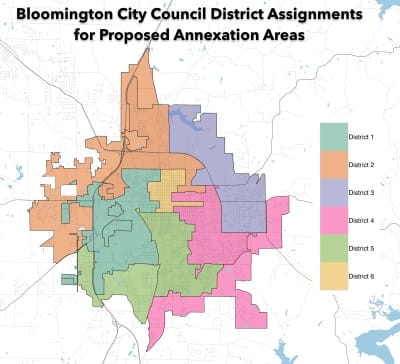Column: Bloomington’s city council should allow future annexees to serve on redistricting advisory commission

All eight annexation ordinances that Bloomington’s city council will consider on Sept. 15 include a date on which their affected areas become a part of the city: Jan. 1, 2024.

That’s less than two months after the next city elections for mayor, city clerk and city councilmembers.
If the effective date were set for Jan. 1, 2023, annexees would be able to participate in the ordinary democratic process for choosing local representatives.
The fact that new residents of the city would have to wait until 2027 to participate in city elections is a source of fair complaint. Even some Bloomington city council members have admitted they feel bad about it.
While the council could vote to amend the annexation ordinances to change their effective dates to Jan. 1, 2023, the council has shown no visible signs that it’s inclined to do that.
If the city council does not want to make annexees city residents in time to give them the right to vote in the 2023 municipal elections, then the council should at least allow future annexees to have some influence on the upcoming process for re-drawing city council districts.
That would mean altering the city ordinance enacted late last year that establishes a citizens redistricting advisory commission (CRAC). Only city residents are allowed to serve on the nine-member group.
The CRAC’s membership requirements should be altered to allow people to serve on the CRAC, if they live in areas that are subject to an enacted annexation ordinance.
The CRAC is supposed to be established at the start of the year following each decennial census, exist for two years, then dissolve. That means the first edition of the CRAC was actually supposed to be established Jan. 1 of this year. As of Sept. 6, 2021, none of the nine members have been appointed.
What’s the logic behind establishing the CRAC a year ahead of the calendar year when the city council is required to redraw its district boundaries?
The reasoning is related to the re-precincting work that the county government will be doing in the next few weeks. The idea is that Bloomington’s CRAC should provide input to county commissioners on the drawing of precinct boundaries inside the city.
Because of the lateness of the 2020 census numbers—due to the pandemic—county commissioners have about six weeks this year to complete work they would ordinarily have six months to do.
Given the compressed timeframe of this year’s work by the county government, it now looks unlikely that the city council could act soon enough to seat the first edition of the CRAC, in time for the CRAC to provide input to the county’s re-precincting work.
The CRAC’s own work on council districts could not start for another few months anyway. So Bloomington’s city council should take advantage of that time to revise the ordinance establishing the CRAC, before trying to seat the first nine members.
Why do city council districts have to be redrawn at all?
City council districts have to be evaluated for possible reconfiguration in connection with the decennial census. And based on the 2020 census results, the current six council districts are out of kilter by about 35 percent. That already points to a need to redraw the council district boundaries.
Additional population pressures pointing to redrawing of Bloomington city council districts come from annexation. Each annexation ordinance assigns its area to one of the existing council districts. But those are in some sense just placeholders, fulfilling a statutory requirement that the ordinance assign the area to some city council district.
District 6 and District 3 are assigned none of the new territory in the annexation proposals, which will make the population imbalance even more severe.
If annexees aren’t able to vote in the 2023 elections, they should at least have the potential to have some influence—through membership on the CRAC—on the shape of the city council districts where they will be living.
If councilmembers are worried about possible retaliation by annexees through their efforts on the CRAC, the failsafe is that the city council will have the final say about where the district boundaries get drawn. The CRAC is, as its name indicates, just an advisory body.
Revising the ordinance establishing the CRAC should rise to a priority for the council after decisions on annexation are made and the 2022 budget is approved in mid-October.




Comments ()